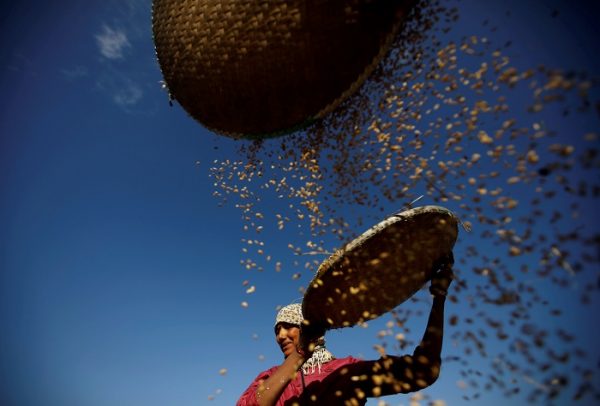Farms and agricultural businesses are facing labour shortages due to lockdown measures and a decline in migrant workers. Transporting harvests to markets is another a challenge, and unsold seasonal vegetables and fruits are going to waste as restaurants, hotels and schools close. While disruptions in food production, processing and distribution are causing farm-gate prices to fall for perishable products, retail prices of some staple food items, fresh vegetables and fruits are rising sharply due to panic buying and higher transportation costs.
Sudden border closures and trade restrictions add temporary strain on food security for import-dependent countries. The retail prices of rice and wheat rose in several developing economies as countries adopted temporary trade restrictions aiming to stabilise their domestic food supply. Major rice exporters including Vietnam, Cambodia and Myanmar imposed export restrictions on rice while Russia, Kazakhstan and Ukraine did the same for wheat.
The pandemic is shining a spotlight on Asia’s stark inequalities. Household food consumption and nutrition may be significantly affected by loss of jobs and income as well as by limited access to food. The economic slowdown has already dealt a devastating blow to vulnerable workers in developing countries. According to the International Labour Organization, the Asia Pacific region — where seven out of ten workers are in the informal sector with limited social protection and low wages — is suffering the large impact in terms of lost working hours. In the second quarter of 2020, there has been an estimated 13.5 per cent reduction in working hours or an equivalent of 235 million full-time job losses.
A particular concern is the nutrition status of those most vulnerable to the crisis. As schools close, school meal programs are being suspended, significantly affecting access to healthy and balanced diets for children in low-income households. Pregnant women, lactating mothers and young children need access to micronutrient-rich food — such as fresh vegetables, fruits, fish and milk — but these foods are perishable and more vulnerable to supply chain disruptions.
Compared to the 2007–08 food crisis when poor harvests, low grain stocks and high energy prices drove up global prices of major cereal crops, rice and wheat prices have not risen to alarming levels. Driven largely by supply chain disruptions and trade restrictions, the current food security crisis is manageable as long as the pandemic is contained relatively soon.
Still, should the lockdowns be extended, labour and input supply shortages could reduce the scale of crop production. Prolonged disruptions in food supply chains and higher costs in logistics would also limit smallholder farmers’ choices of better priced markets, negatively affecting farm incomes.
Swift, bold and innovative policy interventions are needed to secure food supply chains and mitigate the immediate impact of the crisis. Policy interventions should aim to protect consumers and public health, secure supply chains for producers, and support fair labour, trade, macroeconomic policies and regional cooperation.
Regional authorities should increase the reach and enhance the benefits of social protection programs so that vital support reaches the most vulnerable. Immediate support should also be provided to enhance smallholder farmers’ access to markets.
It is critical to provide financial relief and liquidity support to farmers, agribusinesses and food processors who are under financial stress. Many governments in the region are rolling out fiscal measures aimed at cushioning the immediate impact on farmers, agri-firms and other stakeholders along the food supply chain by providing loans and subsidies for working capital and allowing for debt rescheduling or restructuring.
Increased food prices during the 2007–08 food crisis was largely attributed to export bans on staple food items. Policymakers need to be more careful this time not to turn a health crisis into a food crisis by imposing trade restrictions on food. Enhanced regional cooperation mechanisms such as the ASEAN Plus Three Emergency Rice Reserve could help strengthen the food supply safety net.
Post-COVID-19 agricultural reforms should support a long-term transition from a labour-intensive supply chain to a more resilient and efficient agriculture system that uses smart agriculture and mechanisation. This will help mitigate the impacts of climate change, environmental degradation, and shrinking natural resources on food security. During the transition, adequate support should be provided to smallholder farmers and low-income agricultural communities to increase their profits from farming and benefit from off-farm income generation opportunities. One example is increasing access to affordable digital infrastructure and training.
Wider adoption of agricultural technology such as remote sensing and Geographic Information System-based land and soil management will be needed to address the challenges associated with scaling up agricultural production capacity. These challenges include a lack of financing or public–private cooperation, cumbersome regulatory environments, and policy inconsistencies across various economic sectors.
The COVID-19 crisis is an opportunity for developing economies to start implementing long-sought agricultural reforms. A recent move by India is a good example — India announced in May 2020 a long-awaited plan that deregulates the production, supply, distribution and prices of key food commodities to help provide price assurance for farmers, and allow farmers to freely choose the market.
A shift toward digital agriculture and mechanisation may accelerate in the post-COVID era, and Asia’s developing countries will need to adjust to this new environment to make the agriculture sector more competitive.
Cyn-Young Park is Director for Regional Cooperation and Integration at the Economic Research and Regional Cooperation Department of the Asian Development Bank (ADB).
Kijin Kim is an economist with the Economic Research and Regional Cooperation Department, ADB.
Sunae Kim is a natural resources and agriculture specialist with the South Asia Department, ADB.
This article is drawn from an ADB Policy Brief titled ‘Food Security in Asia and the Pacific Amid the COVID-19 Pandemic’.
This article is part of an EAF special feature series on the novel coronavirus crisis and its impact.

